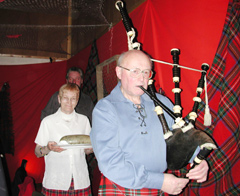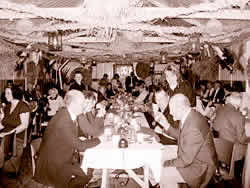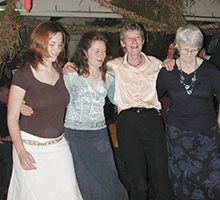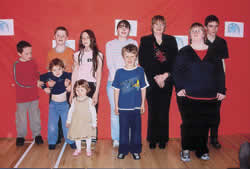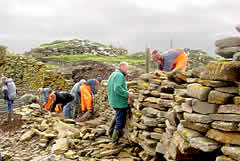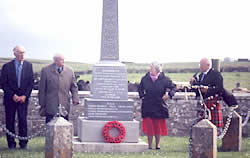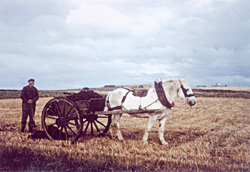“April weather; rain and sunshine both together.”
Here I am again, writing a letter from North Ronaldsay. That old motto, by the way, is very apt this year.I’ve been out of touch for a while, it seems mainly, I think, because I have fallen into lazy ways.
The worst of it is that more important jobs have been neglected in this sort of inactive sabbatical that I have drifted into. Never mind, here goes for another letter.
Today is such a beautiful day that I’ve taken myself outside for a moment. I am actually sitting in a chair enjoying the warmth of the late morning sun and listening to the many sounds of the island.
Yes, this is indeed a fine morning. Daffodils are in bloom no distance from where I sit, and some purple primroses are very pleasing to the eye.
Flies, their species unknown to me, glint silvery in the bright sunshine as they move erratically up and down and speed this way and that.
Hardly a breath of air is to be felt so that the sound of birds comes across the airways from near and far.
A few feet away, two little wrens are calling as they flit around the garden dyke. One, I’m sure, is busy with her nest for she darts in and out of a certain little hole partly hidden with the, as yet, bare branches of an elder tree.
Then in another moment, perched on a prominent part of the dyke, she, or her mate maybe, will sing for a minute or so.
Starlings are chuckling up on a chimney, and sometimes the occasional sparrow can be heard. A blackbird whistles not far away at my neighbour’s house and somewhere up in the blue sky a solitary skylark sings.
This April day is the warmest yet of the spring and, though I’m sure it will not last, it is very pleasant to sit and feel the heat of the sun once more.
In the distance, oyster catchers and lapwings are calling and the curlew, or ‘whaup’, is whistling, sometimes with long sad notes and then a series of thrilling notes.
Once or twice I heard the less- musical croaking of a raven – there are only a few on the island.
But the call of gulls, such as the little common gull and the black-headed gull, that used to follow the plough or harrows in great white clouds in the past, comes familiarly over the still air.
Our Burns Night, which my last letter described, feels like a while ago. Since then our lives have been mainly dominated by the weather which has come upon us in all guises: rain and more rain, snow, strong winds and then days of rain again.
For the time of year everything is aback, with the fields still very wet and bare. Not all that many years ago (1981) by April 23 all the land work – the sowing, and then the planting of tatties – was complete at Antabreck, and probably elsewhere, since the Voar time that year had been particularly fine.
The creel boats were in the process of being checked over and painted, and I further read from my 1981 diary that our drift of creels was out at sea on May 21 – a Thursday since Friday was considered unlucky. Ten days later (counting two non-fishing Sundays) the first shipment to John Steer, the shellfish agent in Stromness, amounted to 77 lobsters.
Well, well, as my Faroese friend always says. I’m now trying to remember what has been happening lately.
Event-wise, two talks were given in the New Community Centre. They were sponsored by the University of Aberdeen in conjunction with the OIC education committee.
The first, called Farming in Scotland 5,000 years ago, was given by Donald Paterson from Aberdeen University.
The second, more recent, talk was titled Alternative sources of energy and the wider sustainability agenda.
Colin Risbridger from Westray was the speaker. A fair turnout attended both presentations, and both proved to be very informative and were illustrated with slides.
Then there was the news of the North Ronaldsay Trust’s substantial financial award for work at the new lighthouse complex (already comprehensively covered in The Orcadian).
Not so long ago Dr Kevin Woodbridge gave a showing of many photographs taken on a family holiday trip to New Zealand. The show, held at the Bird Observatory, was most enjoyable and well attended.
On Saturday, April 15, a very grand pantomime really cheered us all up immensely. Around 60 folk attended, including a number of visitors from the Orkney Mainland.
A party of visiting young folk from one of the EU countries added to the company.
The North Ronaldsay community association (NRCA) ran the evening’s entertainment, held in the Memorial Hall.
Evelyn Gray, NRCA president, welcomed everybody and introduced the evening’s performance. The pantomime Aladdin and his wonderful lamp, originally planned for Christmas, was produced and directed by Sid Ogilvie, who certainly has a great talent for this form of entertainment.
Aladdin is one of the stories from The Arabian Nights and Sid’s adaptation was original, very entertaining and amusingly topical at times (island wise) with one or two local references, for example, to Billalli, the famous Moorish builder.
In the story this character had to build a castle in a week which even he, it was thought, could not manage!
The cast, in order of appearance, was: Narrator, Ann Ogilvie; Widow Twanky, Bob Simpson; Sailor, Gavin Woodbridge; Aladdin, Alison Woodbridge; Owima Bin Liner, Sid Ogilvie; Genie of the ring, Cameron Gray; Genie of the lamp, Lu Shaw; Genie’s mum, Kevin Wood-bridge; Princess Moonsome, Heather Woodbridge; Wozzere, Sid Ogilvie; Sultan, Winnie Scott; Guard, Ronan Gray; Reporter, Gavin Woodbridge.
The play featured a number of scene changes during which suitable background music added to the presentation; and the hall’s old stage and curtains proved invaluable – on its well-worn platform, many a sketch, concert and performance had taken place in the past.
Actors, Sid, Lu and Alison each sang a solo as the play progressed and it was especially encouraging to see the young folk from the school (including Ronan Gray, nursery school) take part with relish. They were Heather Woodbridge, Cameron Gray, Gavin Woodbridge and, not least, Ronan Gray.
The colourful costumes were created with the professional help of Edith Craigie – though I suspect the two male actors, who were appearing as females, had added certain prominent appendages to their persons.
Scenery was a collective affair, painted mainly by the school pupils. It helped to make the production all the more delightful.
Loud applause followed the end of the performance with additional recognition for the four youngest actors at Sid’s request.
Soon a little dance got under way, with the local musicians providing the music. Tea, sandwiches and a grand choice of homebakes were enjoyed half way through the evening.
A raffle in aid of the Memorial Hall funds brought in an excellent figure of over £90. Dancing continued until around one in the morning, when the singing of Auld Lang Syne brought this enjoyable Easter time island get-together to a close.
Now I must finish my letter. It’s well past the ‘heuld’, which is nothing unusual for me.
I’ve just come in from some late byre chores, hoping to find some inspiration outside, but the night is cold with a chilly easterly wind blowing, and the sky is dark and overcast with not a star to be seen. My plan is to get to bed and see what another day brings.
This is another day with the sun shining once again with a fair, warm southerly wind – much better.
How shall I conclude this letter I wonder? I think I will tell you how some of my time has been spent.
I’ve taken to a bit of sustained reading these past months, I have to say, travelling in my mind to the mountains and islands of Scotland, round Cape Horn a few times, from Australia to South America, north to the Arctic and south to the Antarctic, and then back to the Orkney parish of Firth of the 1800s.
One might ask which books have I been reading? Well, apart from other bits and pieces, varied accounts, or whatever, I have really been enjoying a collection of Seton Gordon’s writings called Seton Gordon’s Scotland: An Anthology, compiled by Hamish Brown (published 2005).
I re-read, with the same enjoyment as of old, Eric Newby’s The Last Grain Race, a voyage in a sailing ship from Australia to South America, undertaken in 1938.
Then it was Two Years Before the Mast, by Richard Henry Hanna, a personal narrative of life at sea on a sailing ship. The account traces a voyage from Boston, around Cape Horn, to the California coast.
I must tell you that this is the most wonderful account of life at sea in the early 19th century – not at all romantic I may say. So enthralled was I with the narrative that hardly did I set the book aside as I read day and night to the finish.
My next book took me up to the far north of Canada, and the Eskimos, or Inuit to be more precise, with whom the author, Duncan Pryde, lived some ten years, having moved to Canada in 1955.
His unrivalled record of life with those indigenous people of the far north makes fascinating reading. The book is titled Nunaga.
My literary travels brought me from the far north to the Antarctic with Alfred Lansing’s definitive account of Sir Ernest Shackleton’s epic journey to cross the Antarctic overland.
It also gives an account of his remarkable sea journey, with four other men, in a virtually open boat, across 850 miles of the stormiest ocean in the world to procure help for the rest of his crew.
This incredible, and courageous journey was made after their ship, the Endurance, was crushed by ice. The book is called Endurance ‘the greatest adventure story ever told’ and was first published in 1958.
This excellent reprint contains many of the spectacular photographs taken by the expedition’s photographer, Frank Hurley, and is an addition to the original book.
For my last book I’m back to Orkney to read, once more, John Firth’s wonderful account of life in the Orkneys, Reminiscences of an Orkney Parish. It was published in 1920 — I think there was a reprint in 1974.
Although the book deals mainly with the township of Redland in the parish of Firth as it was, down to the middle of the 19th century, the life described is typical of Orkney as a whole. Now there is a book for folk in Orkney to read.
As I write these last few lines I’m briefly outside my front door again — not sitting this time as it is somewhat chilly. Birds are still calling but less noticeably than I heard them in the warmth and stillness of the other morning.
The day is bright and sunny and the freshening southerly wind is making the yellow daffodils dance.

